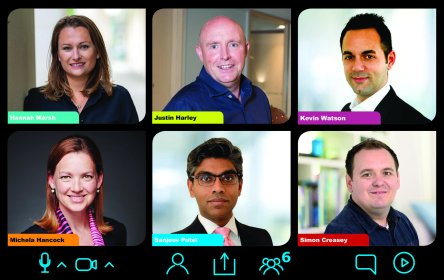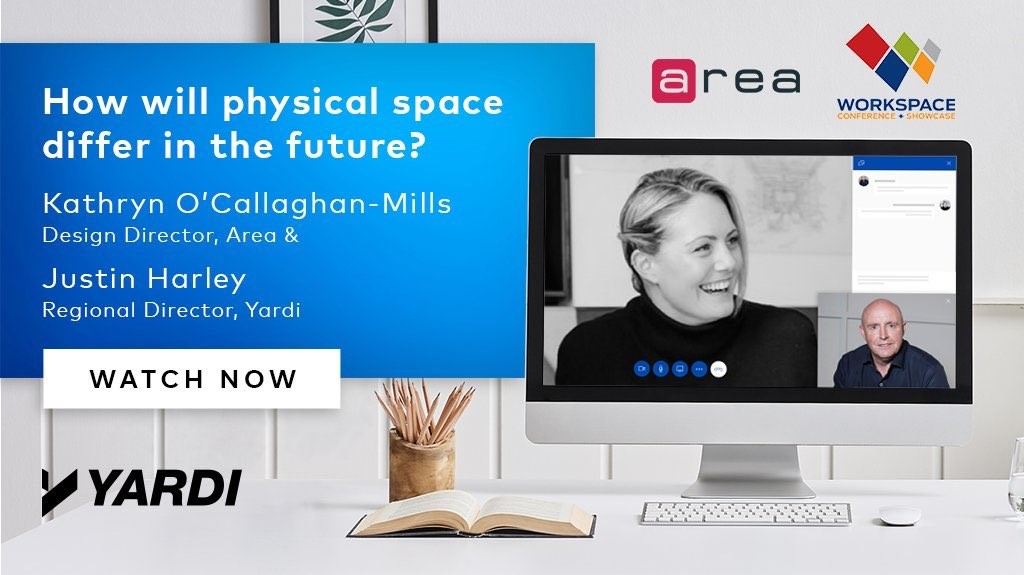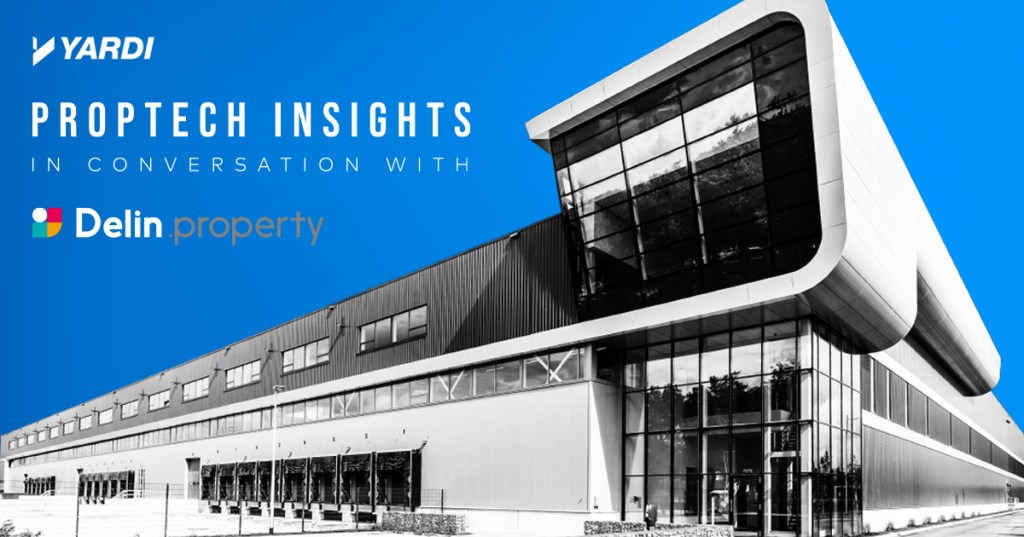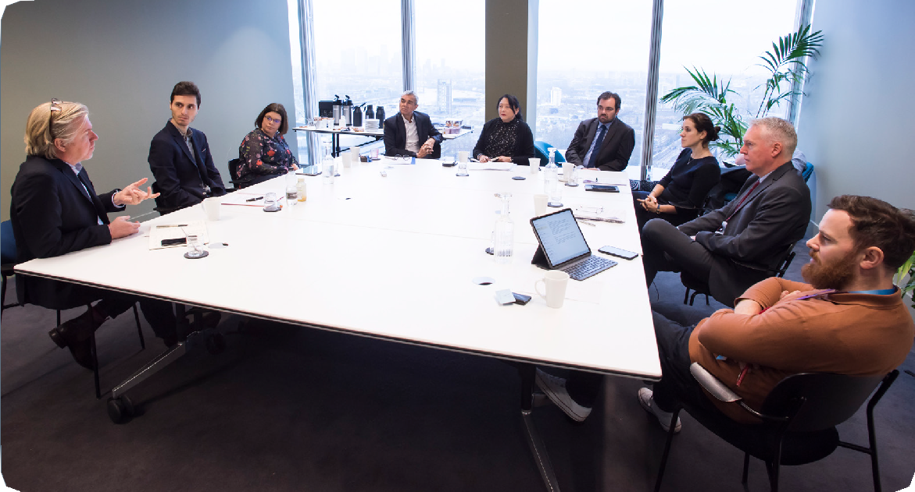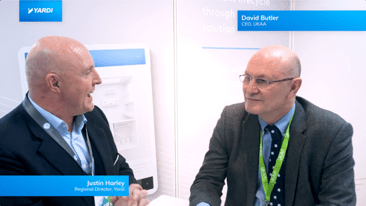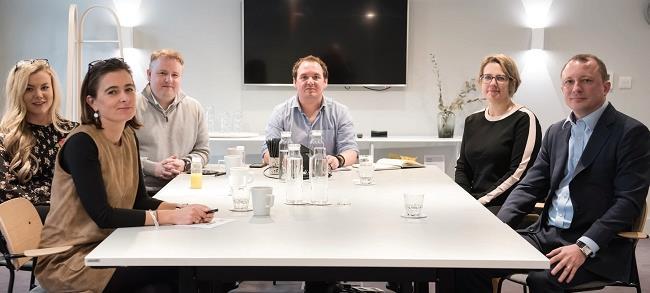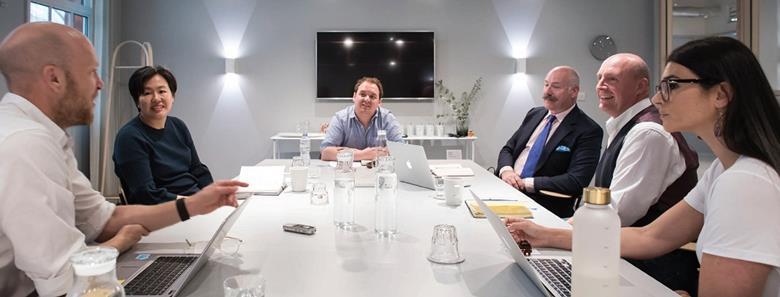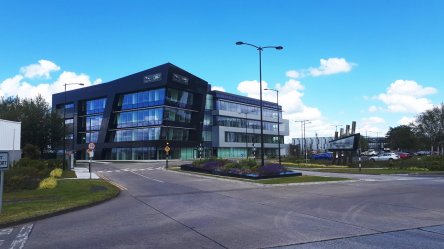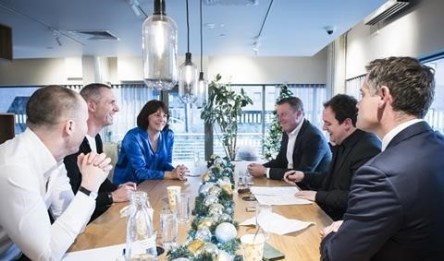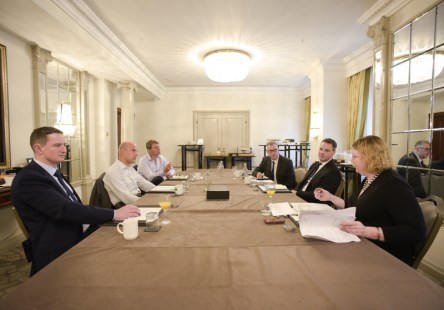Yardi and Property Week recently invited experts from across the build-to-rent sector to take part in a digital debate on the key issues facing the market in the wake of the coronavirus pandemic. The consensus was that despite the challenges posed by the outbreak, there is also an opportunity for BTR to move forward and evolve Michela Hancock Managing director, Greystar Europe Justin Harley Regional director, Yardi Systems Hannah Marsh Co-founder & marketing director, HomeViews Sanjeev Patel Managing director, PPP Capital Kevin Watson Operations and commercial director, Platform Simon Creasey Contributing editor (features), Property Week (chair) Earlier this month, in the latest in the Yardi Think Tank series, Property Week contributing editor Simon Creasey chaired a discussion with key figures in the UK build-to-rent sector on how Covid-19 has affected BTR and the factors driving innovation for investors and residents. Also up for debate was how the pandemic might affect future BTR development. Simon Creasey: What impact has the Covid-19 lockdown had on your operations so far? Kevin Watson: The main impact has been on amenities spaces, which obviously have been closed now for a significant amount of time, and that’s clearly a key part of the value proposition of BTR. On the operations side, the thing that’s been really good to see is the transition to virtual and video viewings and other tools that enable engagement with residents. I think we’ve all been pleasantly surprised at how a lot of people both from the operator side and also from the resident’s side have taken to that. We still have some way to go to make those virtual viewings as interactive and as effective as a face-to-face viewing, but it’s been great to see that come through. Michela Hancock: We’re all kind of dealing...
Flexspace Perspectives
New bitesize videos
Yardi is excited to present a series of bitesize insight videos in partnership with Property Week, ahead of Workspace 2020. This series of interviews gathers perspectives from all corners of the flexible workspace industry, reflecting on the uncertain times that we have found ourselves in during recent months. Justin Harley, regional director at Yardi, captured insights from design company Area, flexspace operator Uncommon and data analytics company The Instant Group. In the last of the series, Harley also summarised Yardi’s technology outlook. How will physical space differ in the future post-covid-19? First to take the Zoom stage, was Kathryn O’Callaghan-Mills, Design Director at Area. Harley jumps straight in with the burning question, “how will physical space differ in the future post-Covid-19?” “The beauty of workspace is that it is so flexible, and the key point of our industry is to give the user a flexible experience,” comments O’Callaghan-Mills. “Operators need to consider two main elements; people and space.” O’Callaghan-Mills explains how operators can make an impact by considering these two pertinent points, including enabling social distancing with space management and rotating people within those spaces. Staying true to the bitesize theme, O’Callaghan-Mills promotes a digestible way of thinking with a ‘the now, the next, and the future’ mindset. With ‘the now’ comprising of immediate measures you can take; ‘the next’ acts as a hybrid of the immediate measures and new normal measures; and ‘the future’ which leverages on the innovation and technology investments you make today. How will the landscape of Flexspace change? Harley also spoke to Chris Davies, Director of Uncommon. Davies expressed that “the traditional faceless office is dead.” And how “the real estate industry needs to support the needs, amenities and service demands of flexspace clients.” “Covid-19 has fundamentally changed the landscape – it’s sped up pre-existing trends such as looking after staff. Staff are the most important part of any business and make up 60-80% of most businesses and flexible office space is the corporate enabler.” Davies explained that office users want a healthier workspace and activity-based working – something that the flexspace market has a hold on over traditional office. Davies expressed how corporate companies will continue to absorb the majority of flexspace market. In 2019 40% of occupiers were corporations – Davies only sees this expanding. Companies signing 5-10-year lease agreements will be a thing of the past in Davies’ opinion. “why wouldn’t a business use a better environment for their staff?” How will the demand for flexible workspace differ post-Covid-19? James Rankin, Head of Research for The Instant Group, gave some insightful perspectives on how the demand for flexspace might differ post-Covid-19. Rankin broke his summary down into three main points explaining that demand for corporates will increase, diversification of location of the office portfolio will be prevalent, and the entrepreneurial sector will flourish. Rankin shared insights from a recent research project conducted by Gartner; “Flexspace operators are moving away from the reactionary thought process that Covid-19 has seen them take, and are now moving to make more strategic decisions about the future of flexible workspace. They are looking to reduce costs, make efficiencies and increase the flexibility of their portfolios as a whole.” Diversification of the office portfolio will be ever more important Rankin explained, “we’ve seen a large number of companies look at how they can expand out of large metropolitan, central hubs.” Rankin explained that the supply isn’t there yet in suburban markets. “We’ve seen a spike in interest for flexible workspace. 5 out of our top 13 global coworking markets are now showing interest levels higher than pre-Covid-19. The bounce back is starting to speed up.” Technology Insights & Predictions Last but not least, Harley closed the Bitesize series with a summary of his predictions and insights that Yardi has taken from clients in the industry. “The future of flexible workspace is healthy and positive,” Harley states. Harley...
Yardi Proptech Insights
With Delin Property
In the latest edition of Yardi Proptech Insights, Yardi regional director Richard Gerritsen speaks with Bart de Sitter and Jay Lelie of Delin Property about the company’s efforts to design innovative warehouse spaces that are efficient and functional as well as attractive for workers. With the growing need to attract and retain ecommerce employees for order fulfillment, warehouse spaces with natural light and employee-friendly amenities like lunch and break spaces are more important than ever. Interconnected spaces for warehouse activities and offices for managers and admin staff are also a priority. “We are hearing from our clients that retention of personnel is becoming more and more difficult, and we want to help our clients make a difference for their workforce, and help their employees be proud when they arrive at work,” said de Sitter, the company’s development director. That means moving away from boring, box-like industrial development norms. “In our designs we put the labor force first, creating a warehouse that provides a better workplace,” said Lelie, asset and leasing manager. Design schemes show massive windows, creative office integrations, and terrace-like areas for worker breaks. The company invests and develops industrial space in the Netherlands, UK, and Spain. Use of forward-thinking PropTech is also important to Delin Property, which continues to adapt and improve its technology management platform using Yardi products. Improving communication with tenants, on site safety and automating business processes have been two PropTech priorities for the company, shared de Sitter and Lelie. Watch the video below for more PropTech insights from this valued Yardi client. Learn more at...
Getting Match Fit
With Get Living
Yardi recently partnered with the UKAA and Get Living to deliver a webinar which explored the effects that Covid-19 has had on the build to rent market. Yardi’s special guests from Get Living, Chris Armstrong, Brand, Technology and Experience Leader and Ian Gibbs, Director of Neighbourhoods, shared their experience on how brand, technology and operations have come together through the pandemic. Justin Harley, regional director at Yardi, kicked off the webinar by sharing some interesting technology trends that Yardi had collated throughout the pandemic. Harley highlighted that technology should be at the heart of any business as the need to be ‘digital-ready’ grows. The count of virtual tours, online applications and resident app downloads are at an all-time high, and data analysis from Yardi shows that resident app usage has doubled since lockdown. Underlying technology has become more essential than ever before. “Technology is a critical part of a business’s infrastructure, just like the physical foundations of any building” said Harley. He posed the question, “when we’re out of lockdown, will these tech tools stay crucial to businesses?” Are you Match Fit? The Get Living duo, Gibbs and Armstrong, scattered sporting analogies throughout the webinar as they compared their response to Covid-19 as becoming ‘match fit’. “We’ve been working on becoming ‘match fit’ for some time now. Gibbs compared Get Living as being ‘at times close to the top of the table’ before new opponent Covid-19 arrived, challenging the team in more ways than they were prepared for. Armstrong compared the Get Living team to being stood on the side lines, discussing the best tactics to take to win the match. He said their first step was to get the right people in the room and to talk it through about how to play...
Next Steps
For international proptech
Yardi’s vice president of international, Neal Gemassmer, recently spoke with the UK Proptech Association (UKPA) about the future of international proptech. Their conversation is reprinted below. Yardi started out as a small software start-up. Now, moving towards Yardi’s fourth decade, how have you seen technology evolve? Gemassmer: A lot has changed since 1984. Since then, Yardi’s technology road map has delivered consistent innovation as we remain focussed on meeting the evolving needs of the real estate industry, and helping our clients serve customers and improve business outcomes. As one of the earliest property management software start-ups, Yardi was founded on core property management and accounting. Since then, we have greatly expanded our range of products and services. Being one of the first real estate technology companies to transition to the cloud, our SaaS model has proven to be hugely successful. With a focus on mobility, connectivity and efficiency for users, we now provide a unique role-based ecosystem of solutions and interfaces for key positions in real estate management. Whether you’re an asset manager, investment manager, property manager or marketer, Yardi offers a range of solutions that are intentionally designed to connect teams across the entire real estate lifecycle, while leveraging a single source of data. Yardi now employs over 7,000 people worldwide and are active in over 80 countries, serving clients that invest in and operate a wide variety of real estate asset classes, from fund and asset management, commercial including office, industrial and retail, coworking and flexible workspace to residential including build to rent, PRS and student. Can you share any insights into the latest innovations at Yardi? What are you most excited about in the product pipeline? Gemassmer: We have creatively consolidated Yardi’s technology solutions into four main principles: Fully connected real estate management...
Movers and Shakers
Build to Rent Forum Recap
Movers & Shakers hosted another impactful Build to Rent Forum on Thursday, Feb. 27, where eager build to rent professionals gathered to debate a range of topics impacting this ever-growing market. Movers & Shakers Chairman David Jennings opened the day with an inspiring video of Greystar’s 2,000-home Greenford Quay development, showcasing a great example of the high standard of homes the industry has to offer. Adam Challis, Executive Director, EMEA Living Research & Strategy at JLL, reaffirmed the previously controversial notion that home ownership isn’t all that matters. As an industry, real estate should be focused on product quality and geographical diversity. Challis tapped into the importance of sustainability and thought provokingly asked which company in the market would be the first to achieve zero carbon emissions whilst being able to offer affordable rental prices. Later in the day, Rebecca Taylor of Long Harbour agreed with the sentiment and stated that as well as operating buildings more efficiently, sustainability must also be entrenched in construction and waste management. News from the Frontline The passion and enthusiasm to see more collaboration in the market was apparent, especially when it comes to data sharing. Michela Hancock, Managing Director, Development & Construction, Greystar Europe, shared some interesting demographic data from Greystar’s Salemakers development. Hancock explained how Salemakers is occupied by 50% students, a figure much higher than expected, that the average age of build to rent residents is 29, and that 48% of residents are male. Ian Gibbs, Director of Neighbourhoods, Get Living, delved into behavioural data sharing that 20% of the East Village population transfer internally when relocating because they know the Get Living brand. Gibbs also stated that 50% of people who have lived in a tall, residential tower building, are more likely to rent...
Tackling the Climate Crisis
Yardi Think Tank
Property Week and Yardi brought together a host of leading industry figures at The Office Group, The Shard In London to discuss what the property industry is doing to tackle the climate crisis. The panel: Neal Gemassmer, Vice president, international, Yardi Sam Carson, Director of sustainability innovation, Carbon Intelligence Janine Cole, Director of sustainability and community, Great Portland Estates Alex Green, Assistant director, British Property Federation Malcolm Hanna, Sustainability manager, real assets, LGIM Caroline Hill, Corporate affairs and sustainability director, Landsec David Partridge, Joint chief executive, Argent Related Steven Skinner, Chief executive, HB Reavis Liz Hamson, Editor, Property Week (chair) What is the industry doing to address the climate crisis? Has it woken up to the scale of the problem and started taking the right action, or is it still in the talking phase? Skinner: I ask the question in a slightly different way. Is the ambition the right ambition? Is the ambition big enough? I think we are slowly moving away from an accreditation-based approach to sustainability, but is that happening quickly enough? Is that going far enough? What key areas should the property industry focus on? Hill: I think you have to start from the fundamental facts and listen to the science. The built environment is responsible for nearly 40% of global carbon emissions and that is a fact. So we, as the property industry, have an enormous role to play in tackling climate change – it is drilling down into your particular business and looking at what can you do. At Landsec, our focus is on carbon reduction and energy reduction. Setting really bold and ambitious targets and making progress each year towards them. But each agent in the property industry – architects, designers, engineers, developers – have all got a different role to play. It is about finding your space and then going for it. Partridge: We have to constantly look at innovation and think how much can I do. So even back in the mid-2000s when we got planning permission for King’s Cross, we committed to being 20% better than building regulations. So we built in a central energy centre that provides heating, cooling and electricity. There is no boiler in any of the buildings – it is all provided centrally. Off the back of that we have been able to get BREEAM ‘outstanding’ ratings for every single one of our office buildings. Someone told me the other day that 10% of all the BREEAM ‘outstanding’ buildings [in the UK?] are at King’s Cross. I did not even know it because you sort of see it as part of what you do anyway. How big a problem is embodied carbon for the industry? Hill: When we started with our new sustainability strategy five years ago, one of the first things we did was a full carbon-footprinting exercise with the Carbon Trust looking at the whole range of activities that Landsec does. And what that told us is that our scope three is the absolute lion’s share of our footprint. So for us, that is how we build our buildings through our supply chain with our contractors, and then there is the energy-in-use of our occupiers. And so our programme has for years focused on embodied carbon because we know that is where our biggest footprint is. Hanna: The other thing to remember about embodied carbon is if you think about the operational carbon that will be emitted over the lifetime of the building, which could be anything from 10 to 50 years, the embodied carbon is right up front. In terms of our approach, L&G has had targets in place for quite a few years and we recently achieved our previous 10-year target. So we are in the process of updating our science-based targets for the next 10 years. What does the industry need to do to address the embodied carbon...
UKAA Expo 2020
Key Takeaways
It was great to see 400+ people representing the UK’s fast-growing build to rent sector last week at the UKAA Expo 2020; the third event of its kind hosted by The UKAA. Yardi was there in full force with a team of seven passionate residential specialists, all eager to learn, network and engage with the market. Early bird catches the reverse-trade show worm For many, the day started at 10am, but for the exhibitors and operators, it was an earlier start. A conventional tradeshow concept was flipped on its head at The Reverse Tradeshow, giving exhibitors the opportunity to attend 10-minute quickfire meetings with operators. It is great to see companies like EcoWorld, Folio London, Henley Investment Management, PLATFORM_ and Packaged Living investing time into further supporting the growth of the market. Networking and more networking It was all systems go when the doors opened at 10am. The exhibition was home to suppliers from all corners of residential real estate, including PropTech companies, law firms and regulatory organisations. Market Perspectives We were keen to ask other eventgoers how they found the day and get a perspective of their understanding of the market. Justin Harley, Regional Director at Yardi interviewed Lesley Roberts, President of the UKAA and Partner & Executive Director at Allsop, who advised BTR operators to be passionate about customer service, understand the market and find good suppliers. Justin also interviewed Paul Belson, PRS & BTR Investment Consultant who recognised the increase in PropTech innovation and The UKAA’s CEO, Dave Butler, who explained the key to success is to know your customer. Click on each image to watch the full interviews. Session Take-Aways Richard Lankshear, Innovation Manager of NHBC was first to take to stage where he gave some inspiring...
International Outlook...
Tech will dominate the decade
Editor’s note: the below perspective on 2020 and the decade ahead for technology and real estate comes from Neal Gemassmer, vice president of international for Yardi. Originally published in Property Week, it is reprinted here with permission. The festive period was an invitation to reflect on the year gone by and the year ahead, even more so than usual. After all, it was the end of one decade and the beginning of another. Naturally enough, all eyes are on Brexit, but from a real estate perspective the impact that technology is having on our industry offers the most interesting food for thought. New technology has had a greater impact on property in the last few years than in the previous three or four decades combined. In 2010, the term ‘proptech’ had not even been coined; today, it is ubiquitous. However, in my view we have barely scratched the surface in terms of its influence. In the years to come, it will redefine how real estate functions. Here are a few ideas as to how. First, consider the build-to-rent (BTR) market. More and more investors are moving into the sector and technology has the potential to act as a major enabler. Digital technologies can allow owners and operators to cut out the middle-man – the letting agent – and communicate directly with potential customers, who can view different buildings and get a feel for the quality of the accommodation and the amenities on offer. Virtual reality lets potential tenants view a property remotely, while online tools can arrange physical visits without the need to call or email ahead. Applications and background checks can also take place digitally and customers will be able to sign their lease and pay their deposit online. The whole process will become virtually...
Yardi Think Tank
Achieving Blended Living Success
Earlier this year, Investec published research showing that 91% of investors think ‘blended living’ schemes that incorporate a combination of build-to-rent (BTR), student accommodation, co-living, retirement living and/or serviced apartments will be commonplace in the UK within the next five years. Last month, Yardi and Property Week brought together a panel of residential experts to explore what makes a successful blended living scheme, the importance of good design and how tech can improve customer experience. Panel of experts Christian Armstrong, director of brand, product and technology, Get Living Mark Bladon, director, Investec Georgie Drewery, account executive, Yardi Systems Félicie Krikler, architect and director, Assael Architecture Beth West, head of development management, Landsec Simon Creasey (chair), consulting editor/features, Property Week Blended living schemes are already commonplace in the US – why do you think they haven’t yet really gained traction in the UK? Bladon: For a number of reasons. If you look at the most developed of those sectors in the UK, it would probably be purpose-built student accommodation and that’s only been going in one form or another in a meaningful way for about 10 years. In the US, the investor market for this type of product is much more mature. Also, the BTR market in the UK had a lot of false starts between 2000 and, say, 2010 where people were just not able to get developments off the ground, but that’s all changed now. People have taken a bit of a leap of faith and there is now trading product, so you can benchmark yields and you can look at it on a cashflow basis. So what we’ve seen is people that have been in a very specific ‘beds for rent’ sector have realised that they can leverage off their existing operational platform, off their infrastructure, off the location – there’s so many things they can now do to broaden their horizon. What are the key ingredients that you need to make a blended living scheme work for all residents, particularly in terms of things like amenities provision? Armstrong: Amenities are really important but you have to think ahead, do some research and speak to your existing residents and prospective residents about what amenities they would actually use. I’ve seen some stunning stuff on schemes like barbecue terraces and outdoor terraces and then it hits me that we live in the UK – this is not the US. So I’m going to be sitting there with my cappuccino on the outdoor terrace with the froth blowing off! Bladon: That’s where the skill comes in. These schemes still have to make a profit, so you can’t just keep pouring money in. Somebody described it as an ‘amenities arms race’. They’re almost turning student accommodation into hotels and then they’re charging students £350 a week. As a result, you might end up with a half-empty property. The most successful operators are going to be the ones that can find the right balance. West: That’s why I think we haven’t reached that maturity point yet – this amenities arms race is a very immature reaction to what people think is a single market and a single customer for this product, but there are loads of people who want this product. If we’re going to build housing that attracts a broad range of different people staying for a long time then we have to think about offering a variety of different affordability points. Bladon: I think there’s another issue that lends itself to a blended portfolio and that’s the power of building a brand that can be used across the whole lifecycle of your tenant. So you start with your student, then co-living, then they get into their mid-20s and they want to move into BTR. That [BTR] can take them from being single, to married with children and living in a three-bed, all the way up to potentially the age of 60, when they might move into...
Coworking Tech Success...
How Us&Co Does It
With shared space workplaces becoming ever more common, it’s important to have the right technology to ensure client success and happiness. Us&Co offers private offices and coworking space in London and Dublin and has a devised a successful model that serves professionals of all kinds. We spoke with Sylvi Wilamowska, head of operations at Us&Co, to find out how on-site tech fits into that experience. An experienced Industry professional, Wilamowska enjoys helping businesses grow and succeed by providing professional workspace they can be proud of, and by taking away the hassle of day to day building management of their own space. Tell us about Us&Co and the company values, mission & objectives? Wilamowska: Us&Co seeks to provide beautifully designed, high-end, professional workspaces, with a variety of uses. We offer our clients space where they can grow and thrive, which is complimented by first class service, delivered by our onsite team and partners. We are strong on design and appeal to a wide variety of businesses. We major on quality furniture, good natural light and space. Whether our clients are from the financial or tech sectors, they expect excellent IT both in the offices and throughout our extensive break out areas. Client satisfaction and therefore retention is our main objective which we achieve through attentive service from our staff and the best systems available. How does Us&Co fit into that? Wilamowska: The market is expanding fast but so is demand. Some markets are becoming overly competitive and some operators are doing unsustainable deals which are creating challenging trading conditions. At Us&Co, we both own and operate our buildings which gives us stability. We want to expand in a measured and controlled way with a long-term horizon. Prior to the relationship with Medusa, what were the...
Race for a Cause
Yardi UK
Providing opportunities for children without homes and supporting those in need is important to Yardi employees around the globe. On July 18th, Yardi’s UK office participated in PropKart, a go-karting event hosted by PropSki with all proceeds benefitting LandAid and Maggie’s Centres. These two heart-warming charities prioritize emotional support and health support. Read on to learn about the exciting race and the special organizations benefitting from the event. PropKart A team of five Yardi employees proudly represented Yardi at PropKart, The Property Industry Karting Championships, at Buckmore Park Kart Circuit – the biggest professional go-karting track in Europe. In their first time participating in a PropSki event, “the team were raring to go! Enthusiasm got the better of one employee who spun out on the track, but all team members were excited by the event,” says Hannah Holmes, a Yardi marketing associate in Great Britain. Among the 23 property industry attendees were Vectos, Greenaway Architecture, and Buckler Environmental – the first, second, and third place winners. Yardi came in further on in the pack, but was most excited to help raise £5,000 for LandAid and Maggie’s Centres, two important and selfless organizations. LandAid LandAid brings businesses and individuals from across the property industry to change lives by working to end youth homelessness in the UK. According to LandAid, around 86,000 people in the UK will be homeless. Through the nonprofit’s inspiring efforts, countless small-medium sized charities across the UK have received investments totaling over £2 million each year, which enables the construction of new buildings and renovation properties. In its work to end youth homelessness, LandAid follows up its funding with strategic advice and property expertise to each project. Last year, LandAid provided 472 homes for vulnerable young people, reaching their three-year target of...
Empowered to Serve
Yardi UK
There are a lot of amazing people on this planet doing some fantastic work in their communities. These people are the heartbeats of nonprofits. Each year, Yardi offices around the globe embark on a mission to support such organizations, their staff members and volunteers. Employees often nominate nonprofits that hold a special place in their heart. Yardi UK is proud to support the following nonprofits in their efforts to create a more just, peaceful, and equitable world. Follow any of the links below to show your support. MK Food Bank– Milton Keynes has experienced its share of economic success. But like all metropolitan areas, many residents struggle with poverty and occasional crisis. With the help of referral agencies, Milton Keynes Food Bank identifies families and individuals facing food insecurity. The non-profit then provides nutritious, essential food items throughout the year. MK Food Bank is fully funded by donations and operated by volunteers. MIND BLMK– Did you know that 1 in 4 people will experience a mental health issue each year? About 1 in 6 will experience a mental health issue at some point in their lives. MIND BLMK wants to ensure that no-one has to face a mental health problem alone. The non-profit offers aid through peer support groups, mentoring, counselling, and corporate programs for clients of all ages in Bedfordshire, Luton and Milton Keynes. Age UK Milton Keynes– Many seniors face isolation and a lack of support. Age UK provides an array of services for older adults in need. Through the organization, seniors can receive counselling and social activities as well as services like cleaning, technology support, and vetted trade recommendations. Keech Hospice– Keech is one of very few organizations that provide free care for adults and children facing life-limiting and terminal illnesses....
Building a Flexible Brand
Yardi UK Think Tank
New Yardi UK roundtable discussion: With more property companies launching flexible workspace brands, Property Week and Yardi gathered a panel of industry experts to identify the secrets of success in a highly competitive market. Justin Harley (JH) – regional director, coworking, Yardi Maria Cheung (MC) – director and head of interior design, Squire & Partners Giles Fuchs (GF) – chief executive, Office Space in Town Alessa McNally (AM) – head of member’s experience, The Office Group John Williams (JW) – head of marketing, The Instant Group Simon Creasey (SC) – (moderator) contributing editor/features, Property Week What are the key components needed to create a successful flexible workspace brand? GF: Location, design, building layout, staff, culture, ethos, IT, consistency of customer service. You can go on forever making a list, but all of those things need to be a part of it. AM: Location is absolutely key. It’s definitely at the top of the list of things we look for when opening up a space. Also member experience. We are here to create a memorable experience for our members. JW: I agree, it’s all about the member experience. The conventional real estate market is still referring to the ‘occupier’ or the ‘tenant’. They’re thinking about looking after an asset and not providing an experience, which is what flexible workspace providers do so well. Once people experience the flexible workspace market I think it’s a shock when they go back to conventional office space because the level of service just isn’t there. What makes a great location for a flexible workspace centre? GF: We previously had a company that covered the whole of the UK and when we opened a property outside London one of my metrics was it had to be five minutes -walk from a Marks & Spencer. In London, our MO is that the location has to be within a four-minute walk – five minutes is probably okay – of a tube or rail hub. JW: I said two years ago that we were going to start to see the rise of second cities and coworking and flexible space becoming a story in the regions and I’m glad to say I was right. Demand for flexible workspace in cities like Bristol, Birmingham and Manchester is increasing by 25% to 30% every single year at the moment. Those secondary cities in the UK are really flying and we’re also seeing that in Europe and in the States. How important is design and fit-out to a flexible workspace brand? MC: It’s become massively important. It should have always been massively important, but the standards have been raised and everyone is really enjoying and realising the benefit of great design in the workspace. It’s no longer about sitting at a fixed desk. We are working in different ways. People want to be able to sit, to stand, to walk around and look at things. Design can enhance and allow different ways of working through the use of things like natural light, biophilia, control of the environment and even acoustics. JH: One of my favourite spaces in London is [flexible workspace provider] Uncommon. They have a lot of biophilia, but it’s the scent in their buildings that’s really beautiful. Smell is one of the most important senses. JW: I think there is a perception of how coworking and flexible space should look; it’s a bit like coworking design bingo. There should be exposed brickwork, free beer, lots of dogs and avocados on tap, but that’s not the case. There is a real individuality of different approaches and different spaces being provided. In the flexible workspace and coworking sector the word ‘community’ pops up time and time again. How important is it to create a sense of community in your flexible workspace? MC: When we created The Ministry [The Ministry of Sound’s private members club and coworking space] we worked closely with them...
Yardi Client Profile
Shannon Commercial Properties
Established in 2015, Shannon Commercial Properties (SCP) is a subsidiary of Shannon Group plc and provides commercial property solutions to commercial, industrial and aviation markets. The company owns and manages seven business and technology parks and has over 1.8 million square feet of office and industrial space, as well as approximately 1,600 acres of development land in over 40 locations across counties Clare, Limerick, Tipperary, Kerry and Offaly in Ireland. “We are focused on expanding our property portfolio in the Mid West region with the provision of further third generation office and industrial facilities, primarily located in Shannon Free Zone West, beside Shannon Airport,” said Jennifer Kearns, finance manager for Shannon Commercial Properties. SCP adopted Yardi Voyager to improve business processes and to gain better control and visibility of operations in one system. The move from disparate systems enabled SCP to handle all aspects of portfolio management including lease management, reporting, budgeting, maintenance, and financials from a single database. Prior to adopting Yardi solutions, SCP was operating across six different management systems. Initially, a new structure was proposed which detailed a four-system approach: property management, financial management, debt management and document management. However, after further examination and detailed discussions with Yardi about the company’s key needs, it became apparent that SCP could streamline onto just one system, Yardi Voyager. “Streamlining onto a single system has allowed us operate with a more reliable set of data. Multiple systems had resulted in unreliable data, which had increased the potential for inaccurate reporting. Combined with the powerful reporting functionality with Voyager, SCP is far better positioned to make strategic decisions than previously,” said David Neylon, capital sales executive for SCP. Gaining control over workflows was a key driver in SCP’s move to Yardi Voyager. Voyager enables SCP...
Build to Rent Update
Yardi UK Think Tank
Yardi UK invited a team of northern property experts to The Slate Yard, a build-to-rent (BTR) development in Salford managed by urbanbubble, to discuss how the relatively nascent sector is evolving in the north of England and to explore the main obstacles that stand in the way of BTR’s future growth in the region. Participating in the discussion were: Michael Howard (MH), managing director, urbanbubble Matt Crompton (MC), joint managing director, Muse Developments Adam Higgins (AH), founder, Capital & Centric Shelagh McNerney (SM), head of development, Salford City Council Gavin Taylor (GT), regional general manager, Far East Consortium Simon Creasey, consulting editor (features), Property Week (chair) Where have we seen significant levels of BTR development take place in the north to date and why? MC: Manchester is streets ahead of other cities at the moment. I guess it comes down to the rental levels that you need to derive from occupiers and the void levels you can accommodate, which filters through the financial model to result in whether something is developable or not. The dynamics in Manchester work because you can see lots of activity happening here, but you don’t see as much activity happening in other strong northern cities – Liverpool, Leeds and the like. The same dynamic must exist in those cities in terms of agile workers that want to live there and have the flexibility of the BTR offer, but rents need to get to a level where developments become viable. SM: You can’t separate what’s going on in the housing market [in Greater Manchester] at the moment from all those large new employers coming into the city and I think that’s what distinguishes the area. While those other northern cities have got great assets and things to offer, it’s just the sheer...
Food Bank Fridays
Yardi UK Fights Hunger
Staff at the Yardi Milton Keynes office are cleaning out their home pantries. But they’re not checking for expiration dates—they’re collecting items for the Milton Keynes Food Bank. Located in Buckinghamshire, about an hour northwest of London, the Yardi UK office employs over sixty team members, and they hope to make a big impact. As part of Yardi’s philanthropy program, the UK team started a charity committee. They sent out a survey to gather feedback and decide which charities to support as a team. The group wanted to keep things local and at first chose a handful of organizations to contribute to. But after the initial charity drive, members of the team had a desire to get involved with something a bit more hands-on. Hannah Holmes and Martin Gedny from the marketing team took a trip to the local food bank. Both learned a great deal about the types of people who benefit from the organization. “It was such an insightful experience that we decided to get involved, and at the very least, set up a donation box,” said Hannah Holmes, marketing associate. “The collection has been a massive hit, and it’s just a start. We want to also encourage team members to get down there and volunteer as well,” said Martin Gedny, senior manager, EMEA marketing. The Milton Keynes Food Bank, recipient of the Queen’s Award for Voluntary Service, aims to educate locals about the realities of hunger in the area. Long believed to be an issue only in developing countries, hunger is a very real threat; even in prosperous communities, many families live on the edge of poverty. And since the food bank relies entirely on contributions from local schools, churches and businesses, every donation counts. Each week, the team checks the...
Proptech Innovations
Secrets for Success
Ed. Note: Neal Gemassmer (pictured, right) is vice president of international for Yardi. This piece on global real estate technology adoption was originally authored for Property Week. It is relatively easy to raise a few hundred thousand pounds and start a company, so I think the number of new proptech start-ups will continue to grow exponentially. It may have been a relatively late adopter where technology is concerned, but the real estate industry is now embracing it. Thanks to the advent of simpler programming languages, the accessibility of cloud storage and the weight of investment capital aimed at the sector, setting up a proptech company has never been easier. On top of that, the now widespread use of apps offers a simple way of getting your technology into customers’ hands via the App Store or Google Play. With this in mind, it is no wonder that new companies are springing up in the sector on an almost daily basis, each of them aiming to solve a particular problem or simplify a complicated process. But as the property industry’s use of – and understanding of – technology becomes more sophisticated, it is technologies that make a fundamental difference to the way businesses work and create real value for their customers that will succeed. Although it has only been encapsulated in a neat buzzword in the last couple of years, proptech has been around in one form or another for far longer. Yardi Systems was founded in 1984 as a small software start-up in the property management sphere and has grown to become one of the largest companies in the sector, learning a lot along the way. In the US residential market, where Yardi has its roots, customers have been able for many years now to identify a...
British Mixed-Use
Yardi Real Estate Think Tank
Editor’s Note: As part of a recurring series in partnership with Property Week, Yardi hosts Think Tanks on real estate development trends in Great Britain. Recently, Yardi brought together a panel of experts to discuss future developments in mixed use, a concept that is gaining traction in the region. The Panelists: Victor Nicholls Assistant Chief Executive – Bracknell Forest Council Michael Auger Regional Director, South – Muse Developments Alistair Shaw Managing Director (TV Centre) – Stanhope Ben Giddens Executive Director – Development – Quintain Alan Harris Partner – Montagu Evans Claer Barrett Personal Finance Editor – Financial Times (chair) CB: Let’s begin by debating what have been the biggest changes to mixed-use over the past decade. BG: The biggest change was the last recession and what that meant for development sites. With the residential tap turned off, you had to look to other uses to bring schemes forward. MA: Mixed-use is the new normal. The biggest change has been the perceptions of funders and occupiers. Ten years ago, they might have felt a mixed-use scheme was ‘pushing the boundaries’ and it was hard work to convince funders in particular that a scheme was going to succeed. Now, they actually want to invest in mixed-use schemes – that’s a fundamental shift. VN: [There is more] enthusiasm from local authorities towards mixed-use, and much more flexibility. Yes, we like our zoning and masterplanning, but that comes from the pressure we’re under to deliver housebuilding targets. But I definitely see more flexibility in the public sector. BG: We have flexible planning consent on several plots of land at Wembley Park where we have outline consent from the local authority to develop offices, residential, hotel space or student accommodation above ground-floor retail. This allows us to respond...

